Recovery of Soil Processes in Replanted Mangroves: Implications for Soil Functions
Abstract
1. Introduction
2. Materials and Methods
2.1. Study Sites
2.2. Soil Sampling
2.3. Soil Chemical and Physical Analyses
- F1—exchangeable and soluble Fe, extracted by 1 mol L−1 MgCl2 solution at pH 7, agitated for 30 min;
- F2—carbonate-associated Fe, extracted by 1 mol L−1 NaOAC solution at pH 5 (adjusted using acetic acid), agitated for 5 h;
- F3—Fe in ferrihydrite, extracted by 0.04 mol L−1 hydroxylamine + 25%acetic acid (v/v) solution at 30 °C, agitated for 6 h;
- F4—Fe in lepidocrocite, extracted by a 0.04 mol L−1 hydroxylamine + 25% acetic acid (v/v) solution at 96 °C, agitated for 6 h;
- F5—Fe in crystalline oxyhydroxides, extracted by a 0.25 mol L−1 Na3C6H5O7 (sodium citrate) + 0.11 mol L−1 NaHCO3 (sodium bicarbonate) and 3g Na2S2O4 (sodium dithionite) solution at 75 °C, agitated for 30 min;
- F6—Fe in pyritic forms (extracted after previous removal of silicates using 10 mol L−1 hydrofluoric acid, followed by agitation for 16 h and removal of organic matter using concentrated sulfuric acid, agitated for 2 h), using a concentrated nitric acid solution.
2.4. Mineralogical Characterization by X-ray Diffraction (XRD) and Scanning Electron Microscopy (SEM)
2.5. Statistical Analysis
3. Results
3.1. Particle Size Distribution
3.2. Soil Carbon Stocks
3.3. Fe Partitioning and Total Contents of Fe and S
3.4. Mineralogical Characteristics (XRD and SEM Analyses)
3.5. Discriminant Analysis
4. Discussion
4.1. Particle Size Distribution and Soil Carbon Stocks in the Different Replanted Plots
4.2. Responses of Fe, C, and S Geochemistry to Revegetation: Implications for Soil Functions
5. Concluding Remarks
Author Contributions
Funding
Institutional Review Board Statement
Informed Consent Statement
Data Availability Statement
Acknowledgments
Conflicts of Interest
References
- Costanza, R.; de Groot, R.; Sutton, P.; van der Ploeg, S.; Anderson, S.J.; Kubiszewski, I.; Farber, S.; Turner, R.K. Changes in the global value of ecosystem services. Glob. Environ. Chang. 2014, 26, 152–158. [Google Scholar] [CrossRef]
- Costanza, R.; D’Arge, R.; de Groot, R.; Farber, S.; Grasso, M.; Hannon, B.; Limburg, K.; Naeem, S.; O’Neill, R.V.; Paruelo, J.; et al. The value of the world’s ecosystem services and natural capital. Nature 1997, 387, 253–260. [Google Scholar] [CrossRef]
- Wang, M.; Cao, W.; Jiang, C.; Yan, Y.; Guan, Q. Potential ecosystem service values of mangrove forests in southeastern China using high-resolution satellite data. Estuar. Coast. Shelf Sci. 2018, 209, 30–40. [Google Scholar] [CrossRef]
- Jardine, S.L.; Siikamäki, J.V. A global predictive model of carbon in mangrove soils. Environ. Res. Lett. 2014, 9, 104013. [Google Scholar] [CrossRef]
- Adhikari, K.; Hartemink, A.E. Linking soils to ecosystem services—A global review. Geoderma 2016, 262, 101–111. [Google Scholar] [CrossRef]
- Tripathi, R.; Shukla, A.; Shahid, M.; Nayak, D.; Puree, C.; Mohanty, S.; Raja, R.; Lal, B.; Gautam, P.; Bhattacharyya, P.; et al. Soil quality in mangrove ecosystem deteriorates due to rice cultivation. Ecol. Eng. 2016, 90, 163–169. [Google Scholar] [CrossRef]
- Faridah-Hanum, I.; Yusoff, F.M.; Fitrianto, A.; Ainuddin, N.A.; Gandaseca, S.; Zaiton, S.; Norizah, K.; Nurhidayu, S.; Roslan, M.K.; Hakeem, K.R.; et al. Development of a comprehensive mangrove quality index (MQI) in Matang Mangrove: Assessing mangrove ecosystem health. Ecol. Indic. 2019, 102, 103–117. [Google Scholar] [CrossRef]
- Kristensen, E.; Bouillon, S.; Dittmar, T.; Marchand, C. Organic carbon dynamics in mangrove ecosystems: A review. Aquat. Bot. 2008, 89, 201–219. [Google Scholar] [CrossRef]
- Otero, X.L.; Macías, F. Biogeochemistry and Pedogenetic Process in Saltmarsh and Mangrove Systems, 1st ed.; Nova Science Publishers: Hauppauge, NY, USA, 2010; ISBN 978-1-61728-269-0. [Google Scholar]
- de Sousa, R.O.; Vahl, L.C.; Otero, X.L. Química de solos alagados. In Química e Mineralogia do Solo-Parte II—Aplicações; Sociedade Brasileira de Ciência do Solo: Viçosa, Brazil, 2016; pp. 485–528. [Google Scholar]
- Lovley, D.R.; Holmes, D.E.; Nevin, K.P. Dissimilatory Fe(III) and Mn(IV) Reduction. In Advances in Microbial Physiology; Academic Press: London, UK, 2004; Volume 49, pp. 219–286. ISBN 9780120277490. [Google Scholar]
- Alongi, D.M.; Tirendi, F.; Dixon, P.; Trott, L.A.; Brunskill, G.J. Mineralization of Organic Matter in Intertidal Sediments of a Tropical Semi-enclosed Delta. Estuar. Coast. Shelf Sci. 1999, 48, 451–467. [Google Scholar] [CrossRef]
- Chapelle, F.H.; Lovley, D.R. Competitive Exclusion of Sulfate Reduction by Fe(lll)-Reducing Bacteria: A Mechanism for Producing Discrete Zones of High-Iron Ground Water. Ground Water 1992, 30, 29–36. [Google Scholar] [CrossRef]
- Ferreira, T.O.; Nóbrega, G.N.; Queiroz, H.M.; de Souza Júnior, V.S.; Barcellos, D.; Ferreira, A.D.; Otero, X.L. Windsock behavior: Climatic control on iron biogeochemistry in tropical mangroves. Biogeochemistry 2021, 156, 437–452. [Google Scholar] [CrossRef]
- Alongi, D.M.; Wattayakorn, G.; Pfitzner, J.; Tirendi, F.; Zagorskis, I.; Brunskill, G.; Davidson, A.; Clough, B. Organic carbon accumulation and metabolic pathways in sediments of mangrove forests in southern Thailand. Mar. Geol. 2001, 179, 85–103. [Google Scholar] [CrossRef]
- Ye, S.; Laws, E.A.; Wu, Q.; Zhong, S.; Ding, X.; Zhao, G.; Gong, S. Pyritization of trace metals in estuarine sediments and the controlling factors: A case in Jiaojiang Estuary of Zhejiang Province, China. Environ. Earth Sci. 2010, 61, 973–982. [Google Scholar] [CrossRef]
- Machado, W.; Borrelli, N.L.; Ferreira, T.O.; Marques, A.G.B.; Osterrieth, M.; Guizan, C. Trace metal pyritization variability in response to mangrove soil aerobic and anaerobic oxidation processes. Mar. Pollut. Bull. 2014, 79, 365–370. [Google Scholar] [CrossRef]
- Huerta-Diaz, M.A.; Morse, J.W. Pyritization of trace metals in anoxic marine sediments. Geochim. Cosmochim. Acta 1992, 56, 2681–2702. [Google Scholar] [CrossRef]
- Santos Garcia, J.; Sershen; França, M.G.C. Mangrove Assisted Remediation and Ecosystem Services. In Handbook of Assisted and Amendment: Enhanced Sustainable Remediation Technology; Wiley: Hoboken, NJ, USA, 2021; pp. 535–556. [Google Scholar]
- Kelleway, J.J.; Saintilan, N.; Macreadie, P.I.; Baldock, J.A.; Ralph, P.J. Sediment and carbon deposition vary among vegetation assemblages in a coastal salt marsh. Biogeosciences 2017, 14, 3763–3779. [Google Scholar] [CrossRef]
- Sinclair, M.; Vishnu Sagar, M.K.; Knudsen, C.; Sabu, J.; Ghermandi, A. Economic appraisal of ecosystem services and restoration scenarios in a tropical coastal Ramsar wetland in India. Ecosyst. Serv. 2021, 47, 101236. [Google Scholar] [CrossRef]
- Sannigrahi, S.; Zhang, Q.; Pilla, F.; Joshi, P.K.; Basu, B.; Keesstra, S.; Roy, P.S.; Wang, Y.; Sutton, P.C.; Chakraborti, S.; et al. Responses of ecosystem services to natural and anthropogenic forcings: A spatial regression based assessment in the world’s largest mangrove ecosystem. Sci. Total Environ. 2020, 715, 137004. [Google Scholar] [CrossRef]
- Ellison, A.M.; Felson, A.J.; Friess, D.A. Mangrove Rehabilitation and Restoration as Experimental Adaptive Management. Front. Mar. Sci. 2020, 7, 327. [Google Scholar] [CrossRef]
- Van Oudenhoven, A.P.E.; Siahainenia, A.J.; Sualia, I.; Tonneijck, F.H.; van der Ploeg, S.; de Groot, R.S.; Alkemade, R.; Leemans, R. Effects of different management regimes on mangrove ecosystem services in Java, Indonesia. Ocean Coast. Manag. 2015, 116, 353–367. [Google Scholar] [CrossRef]
- Malik, A.; Fensholt, R.; Mertz, O. Mangrove exploitation effects on biodiversity and ecosystem services. Biodivers. Conserv. 2015, 24, 3543–3557. [Google Scholar] [CrossRef]
- Ahmed, N.; Cheung, W.W.L.; Thompson, S.; Glaser, M. Solutions to blue carbon emissions: Shrimp cultivation, mangrove deforestation and climate change in coastal Bangladesh. Mar. Policy 2017, 82, 68–75. [Google Scholar] [CrossRef]
- Chowdhury, R.R.; Uchida, E.; Chen, L.; Osorio, V.; Yoder, L. Anthropogenic Drivers of Mangrove Loss: Geographic Patterns and Implications for Livelihoods. In Mangrove Ecosystems: A Global Biogeographic Perspective; Springer: Berlin/Heidelberg, Germany, 2017; ISBN 9783319622064. [Google Scholar]
- Kauffman, J.B.; Bernardino, A.F.; Ferreira, T.O.; Bolton, N.W.; de Gomes, L.E.O.; Nobrega, G.N. Shrimp ponds lead to massive loss of soil carbon and greenhouse gas emissions in northeastern Brazilian mangroves. Ecol. Evol. 2018, 8, 5530–5540. [Google Scholar] [CrossRef] [PubMed]
- Otero, X.L.; Méndez, A.; Nóbrega, G.N.; Ferreira, T.O.; Santiso-Taboada, M.J.; Meléndez, W.; Macías, F. High fragility of the soil organic C pools in mangrove forests. Mar. Pollut. Bull. 2017, 119, 460–464. [Google Scholar] [CrossRef] [PubMed]
- Barros, F.P.; Santos, D.M.; de Andrade, N.A.; de Freitas, A.L.; Neto, A.C.; Bezerra, D.H.S.; de Leite, M.J.H.; de Brilhante, J.C.A. The natural ecomuseum of mangrove: Educational and reforestation actions/O ecomuseu natural do mangue: Ações educativas e de reflorestamento. Brazilian Appl. Sci. Rev. 2021, 5, 482–497. [Google Scholar] [CrossRef]
- ICMBio. Atlas dos Manguezais do Brasil, 1st ed.; Instituto Chico Mendes de Conservação da Biodiversidade: Brasília, Brazil, 2018; ISBN 9788561842758. [Google Scholar]
- De Fonseca, S.M.; Drummond, J.A. Reflorestamento de manguezais e o valor de resgate para o seqüestro de carbono atmosférico. História Ciências Saúde-Manguinhos 2003, 10, 1071–1081. [Google Scholar] [CrossRef][Green Version]
- Nóbrega, G.N.; Ferreira, T.O.; Siqueira Neto, M.; Queiroz, H.M.; Artur, A.G.; Mendonça, E.D.S.; Silva, E.D.O.; Otero, X.L. Edaphic factors controlling summer (rainy season) greenhouse gas emissions (CO2 and CH4) from semiarid mangrove soils (NE-Brazil). Sci. Total Environ. 2016, 542, 685–693. [Google Scholar] [CrossRef]
- Fries, A.S.; Coimbra, J.P.; Nemazie, D.A.; Summers, R.M.; Azevedo, J.P.S.; Filoso, S.; Newton, M.; Gelli, G.; de Oliveira, R.C.N.; Pessoa, M.A.R.; et al. Guanabara Bay ecosystem health report card: Science, management, and governance implications. Reg. Stud. Mar. Sci. 2019, 25, 100474. [Google Scholar] [CrossRef]
- Soares, M.L.G.; Silva, C.M.G., Jr.; Cavalcanti, V.F.; Almeida, P.M.M.; Monteiro, A.S.; Chaves, F.O.; Duque Estrada, G.C.; Barbosa, B. Regeneração de floresta de mangue atingifa por óleo na baía de Guanabara (Rio de Janeiro, Brasil): Resultados de 5 anos de monitoramento. Geochim. Bras. 2006, 20, 54–77. [Google Scholar] [CrossRef]
- Borges, A.C.; Dias, J.C.; Machado, W.; Patchineelam, S.R.; Sella, S.M. Distribuição espacial de ferro, cobre e chumbo em sedimentos de manguezal em um gradiente de degradação na Baía de Guanabara (Estado do Rio de Janeiro). Quim. Nova 2007, 30, 66–69. [Google Scholar] [CrossRef][Green Version]
- Medina, E.; Cuevas, E.; Popp, M.; Lugo, A.E. Soil Salinity, Sun Exposure, and Growth of Acrostichum aureum, the Mangrove Fern. Bot. Gaz. 1990, 151, 41–49. [Google Scholar] [CrossRef]
- Alvares, C.A.; Stape, J.L.; Sentelhas, P.C.; De Moraes Gonçalves, J.L.; Sparovek, G. Köppen’s climate classification map for Brazil. Meteorol. Zeitschrift 2013, 22, 711–728. [Google Scholar] [CrossRef]
- Nóbrega, G.N.; Ferreira, T.O.; Romero, R.E.; Marques, A.G.B.; Otero, X.L. Iron and sulfur geochemistry in semi-arid mangrove soils (Ceará, Brazil) in relation to seasonal changes and shrimp farming effluents. Environ. Monit. Assess. 2013, 185, 7393–7407. [Google Scholar] [CrossRef] [PubMed]
- Behling, H.; da Costa, M.L. Mineralogy, geochemistry, and palynology of modern and late Tertiary mangrove deposits in the Barreiras Formation of Mosqueiro Island, northeastern Pará state, eastern Amazonia. J. S. Am. Earth Sci. 2004, 17, 285–295. [Google Scholar] [CrossRef]
- Bigarella, J.J. Estrutura e Origem das Paisagens Tropicais e Subtropicais, 3rd ed.; Editora da UFSC: Florianópolis, Brazil, 2003; ISBN 8532802664. [Google Scholar]
- Maia, L.P.; de Lacerda, L.D.; Monteiro, L.H.U.; Souza, G.M. Estudo das Áreas de Manguezais do Nordeste do Brasil-Avaliação das Áreas de Manguezais dos Estados do Piauí, Ceará, Rio Grande do Norte, Paraíba e Pernambuco, 1st ed.; Instituo de Ciências do Mar Sociedade Internacional Para Ecossistemas de Manguezal—ISME-BR, Universidade Federal do Ceará: Fortaleza, Brazil, 2005. [Google Scholar]
- Ferreira, T.O.; Nóbrega, G.N.; Albuquerque, A.G.B.M.B.M.; Sartor, L.R.; Gomes, I.S.; Artur, A.G.; Otero, X.L. Pyrite as a proxy for the identification of former coastal lagoons in semiarid NE Brazil. Geo-Marine Lett. 2015, 35, 355–366. [Google Scholar] [CrossRef]
- Vieira, B.C.; Salgado, A.A.R.; Santos, L.J.C. Landscapes and Landforms of Brazil. In World Geomorphological Landscapes; Vieira, B.C., Salgado, A.A.R., Santos, L.J.C., Eds.; Springer: Dordrecht, The Netherlands, 2015; ISBN 978-94-017-8022-3. [Google Scholar]
- Kjerfve, B.; Ribeiro, C.H.A.; Dias, G.T.M.; Filippo, A.M.; Da Silva Quaresma, V. Oceanographic characteristics of an impacted coastal bay: Baía de Guanabara, Rio de Janeiro, Brazil. Cont. Shelf Res. 1997, 17, 1609–1643. [Google Scholar] [CrossRef]
- Gee, G.W.; Bauder, J.W. Particle-size analysis. In Methods of Soil Analysis: Part 1—Physical and Mineralogical Methods; Soil Science Society of America, American Society of Agronomy: Madison, WI, USA, 1986; pp. 383–411. [Google Scholar]
- Howard, J.; Hoyt, S.; Isensee, K.; Telszewski, M.; Pidgeon, E.; Telszewski, M. Coastal Blue Carbon: Methods for Assessing Carbon Stocks and Emissions Factors in Mangroves, Tidal Salt Marshes, and Seagrasses; Conservation International, Intergovernmental Oceanographic Commission of UNESCO, International Union for Conservation of Nature: Arlington, VA, USA, 2014; Volume 1, ISBN 9782831717623. [Google Scholar]
- Ferreira, T.O.; Otero, X.L.; Vidal-Torrado, P.; Macías, F. Redox Processes in Mangrove Soils under Rhizophora mangle in Relation to Different Environmental Conditions. Soil Sci. Soc. Am. J. 2007, 71, 484–491. [Google Scholar] [CrossRef]
- Otero, X.L.; Ferreira, T.O.; Huerta-Díaz, M.A.; Partiti, C.S.M.; Souza, V.; Vidal-Torrado, P.; Macías, F. Geochemistry of iron and manganese in soils and sediments of a mangrove system, Island of Pai Matos (Cananeia—SP, Brazil). Geoderma 2009, 148, 318–335. [Google Scholar] [CrossRef]
- Otero, X.L.; Lucheta, A.R.; Ferreira, T.O.; Huerta-Díaz, M.A.; Lambais, M.R. Archaeal diversity and the extent of iron and manganese pyritization in sediments from a tropical mangrove creek (Cardoso Island, Brazil). Estuar. Coast. Shelf Sci. 2014, 146, 1–13. [Google Scholar] [CrossRef]
- Siregar, A.; Kleber, M.; Mikutta, R.; Jahn, R. Sodium hypochlorite oxidation reduces soil organic matter concentrations without affecting inorganic soil constituents. Eur. J. Soil Sci. 2005, 56, 481–490. [Google Scholar] [CrossRef]
- Reimann, C.; Filzmoser, P.; Garrett, R.G.; Dutter, R. Statistical Data Analysis Explained; John Wiley & Sons, Ltd.: Chichester, UK, 2008; ISBN 9780470987605. [Google Scholar]
- Krauss, K.W.; Mckee, K.L.; Lovelock, C.E.; Cahoon, D.R.; Saintilan, N.; Reef, R.; Chen, L. How mangrove forests adjust to rising sea level. New Phytol. 2014, 202, 19–34. [Google Scholar] [CrossRef] [PubMed]
- Perry, C.T.; Berkeley, A. Intertidal substrate modification as a result of mangrove planting: Impacts of introduced mangrove species on sediment microfacies characteristics. Estuar. Coast. Shelf Sci. 2009, 81, 225–237. [Google Scholar] [CrossRef]
- Macreadie, P.I.; Anton, A.; Raven, J.A.; Beaumont, N.; Connolly, R.M.; Friess, D.A.; Kelleway, J.J.; Kennedy, H.; Kuwae, T.; Lavery, P.S.; et al. The future of Blue Carbon science. Nat. Commun. 2019, 10, 3998. [Google Scholar] [CrossRef] [PubMed]
- Keil, R.G.; Hedges, J.I. Sorption of organic matter to mineral surfaces and the preservation of organic matter in coastal marine sediments. Chem. Geol. 1993, 107, 385–388. [Google Scholar] [CrossRef]
- Xin, K.; Yan, K.; Gao, C.; Li, Z. Carbon storage and its influencing factors in Hainan Dongzhangang mangrove wetlands. Mar. Freshw. Res. 2018, 69, 771. [Google Scholar] [CrossRef]
- Ezcurra, P.; Ezcurra, E.; Garcillán, P.P.; Costa, M.T.; Aburto-Oropeza, O. Coastal landforms and accumulation of mangrove peat increase carbon sequestration and storage. Proc. Natl. Acad. Sci. USA 2016, 113, 4404–4409. [Google Scholar] [CrossRef]
- Twilley, R.R.; Rovai, A.S.; Riul, P. Coastal morphology explains global blue carbon distributions. Front. Ecol. Environ. 2018, 16, 503–508. [Google Scholar] [CrossRef]
- Fernandes, N.F.; Tupinambá, M.; Mello, C.L.; de Peixoto, M.N.O. Rio de Janeiro: A Metropolis Between Granite-Gneiss Massifs. In Geomorphological Landscapes of the World; Springer: Dordrecht, The Netherlands, 2009; pp. 89–100. [Google Scholar]
- Lacerda, W.A. Shear strength of soils derived from the weathering of granite and gneiss in Brazil. Geol. Soc. London, Eng. Geol. Spec. Publ. 2010, 23, 167–182. [Google Scholar] [CrossRef]
- Ergin, M.; Bodur, M.N. Silt/clay fractionation in surficial Marmara sediments: Implication for water movement and sediment transport paths in a semi-enclosed and two-layered flow system (northeastern Mediterranean Sea). Geo-Marine Lett. 1998, 18, 225–233. [Google Scholar] [CrossRef]
- Guézennec, L.; Lafite, R.; Dupont, J.-P.; Meyer, R.; Boust, D.; Guezennec, L. Hydrodynamics of Suspended Particulate Matter in the Tidal Freshwater Zone of a Macrotidal Estuary (The Seine Estuary, France). Estuaries 1999, 22, 717. [Google Scholar] [CrossRef]
- Berezina, N.A.; Gubelit, Y.I.; Polyak, Y.M.; Sharov, A.N.; Kudryavtseva, V.A.; Lubimtsev, V.A.; Petukhov, V.A.; Shigaeva, T.D. An integrated approach to the assessment of the eastern Gulf of Finland health: A case study of coastal habitats. J. Mar. Syst. 2017, 171, 159–171. [Google Scholar] [CrossRef]
- Ferreira, T.O.; Otero, X.L.; Vidal-Torrado, P.; Macías, F. Effects of bioturbation by root and crab activity on iron and sulfur biogeochemistry in mangrove substrate. Geoderma 2007, 142, 36–46. [Google Scholar] [CrossRef]
- Friesen, S.D.; Dunn, C.; Freeman, C. Decomposition as a regulator of carbon accretion in mangroves: A review. Ecol. Eng. 2018, 114, 173–178. [Google Scholar] [CrossRef]
- Winkler, P.; Kaiser, K.; Thompson, A.; Kalbitz, K.; Fiedler, S.; Jahn, R. Contrasting evolution of iron phase composition in soils exposed to redox fluctuations. Geochim. Cosmochim. Acta 2018, 235, 89–102. [Google Scholar] [CrossRef]
- Bonneville, S.; Van Cappellen, P.; Behrends, T. Microbial reduction of iron(III) oxyhydroxides: Effects of mineral solubility and availability. Chem. Geol. 2004, 212, 255–268. [Google Scholar] [CrossRef]
- Larsen, O.; Postma, D. Kinetics of reductive bulk dissolution of lepidocrocite, ferrihydrite, and goethite. Geochim. Cosmochim. Acta 2001, 65, 1367–1379. [Google Scholar] [CrossRef]
- Lin, S.; Morse, J. Sulfate reduction and iron sulfide mineral formation in Gulf of Mexico anoxic sediments. Am. J. Sci. 1991, 291, 55–89. [Google Scholar] [CrossRef]
- Wang, D.Y.; Zhu, M.X.; Sun, C.H.; Ma, K.; Sun, W.X.; Zhang, X.R.; Sun, Z.L. Geochemistry of iron and sulfur in the Holocene marine sediments under contrasting depositional settings, with caveats for applications of paleoredox proxies. J. Mar. Syst. 2021, 220, 103572. [Google Scholar] [CrossRef]
- Wijsman, J.W.M.; Middelburg, J.J.; Heip, C.H.R. Reactive iron in Black Sea sediments: Implications for iron cycling. Mar. Geol. 2001, 172, 167–180. [Google Scholar] [CrossRef]
- Thanh-Nho, N.; Marchand, C.; Strady, E.; Vinh, T.-V.; Nhu-Trang, T.-T. Metals geochemistry and ecological risk assessment in a tropical mangrove (Can Gio, Vietnam). Chemosphere 2019, 219, 365–382. [Google Scholar] [CrossRef]
- Rasmussen, C.; Heckman, K.; Wieder, W.R.; Keiluweit, M.; Lawrence, C.R.; Asefaw, A.; Blankinship, J.C.; Crow, S.E.; Druhan, J.L.; Hicks, C.E.; et al. Beyond clay: Towards an improved set of variables for predicting soil organic matter content. Biogeochemistry 2018, 137, 297–306. [Google Scholar] [CrossRef]
- Wang, P.; Wang, J.; Zhang, H.; Dong, Y.; Zhang, Y. The role of iron oxides in the preservation of soil organic matter under long-term fertilization. J. Soils Sediments 2019, 19, 588–598. [Google Scholar] [CrossRef]
- Kida, M.; Fujitake, N. Organic Carbon Stabilization Mechanisms in Mangrove Soils: A Review. Forests 2020, 11, 981. [Google Scholar] [CrossRef]
- Kim, J.; Lee, J.; Yang, Y.; Yun, J.; Ding, W.; Yuan, J.; Khim, J.S.; Kwon, B.O.; Kang, H. Microbial decomposition of soil organic matter determined by edaphic characteristics of mangrove forests in East Asia. Sci. Total Environ. 2021, 763, 142972. [Google Scholar] [CrossRef]
- Jimenez, L.C.Z.; Queiroz, H.M.; Otero, L.; Nuto, G. Soil Organic Matter Responses to Mangrove Restoration: A Replanting Experience in Northeast Brazil. Int. J. Environ. Res. Public Health 2021, 18, 8981. [Google Scholar] [CrossRef]
- Sanders, C.J.; Smoak, J.M.; Naidu, A.S.; Araripe, D.R.; Sanders, L.M.; Patchineelam, S.R. Mangrove forest sedimentation and its reference to sea level rise, Cananeia, Brazil. Environ. Earth Sci. 2010, 60, 1291–1301. [Google Scholar] [CrossRef]
- Sanders, C.J.; Smoak, J.M.; Naidu, A.S.; Patchineelam, S.R. Recent Sediment Accumulation in a Mangrove Forest and Its Relevance to Local Sea-Level Rise (Ilha Grande, Brazil). J. Coast. Res. 2008, 242, 533–536. [Google Scholar] [CrossRef]
- Mcleod, E.; Chmura, G.L.; Bouillon, S.; Salm, R.; Björk, M.; Duarte, C.M.; Lovelock, C.E.; Schlesinger, W.H.; Silliman, B.R. A blueprint for blue carbon: Toward an improved understanding of the role of vegetated coastal habitats in sequestering CO2. Front. Ecol. Environ. 2011, 9, 552–560. [Google Scholar] [CrossRef]
- Duarte, C.M.; Middelburg, J.J.; Caraco, N. Major role of marine vegetation on the oceanic carbon cycle. Biogeosciences 2005, 2, 1–8. [Google Scholar] [CrossRef]
- Chmura, G.L.; Anisfeld, S.C.; Cahoon, D.R.; Lynch, J.C. Global carbon sequestration in tidal, saline wetland soils. Global Biogeochem. Cycles 2003, 17, 1111. [Google Scholar] [CrossRef]
- Bouillon, S.; Borges, A.V.; Castañeda-Moya, E.; Diele, K.; Dittmar, T.; Duke, N.C.; Kristensen, E.; Lee, S.Y.; Marchand, C.; Middelburg, J.J.; et al. Mangrove production and carbon sinks: A revision of global budget estimates. Glob. Biogeochem. Cycles 2008, 22, GB2013. [Google Scholar] [CrossRef]
- Raiswell, R.; Canfield, D.E.; Berner, R.A. A comparison of iron extraction methods for the determination of degree of pyritisation and the recognition of iron-limited pyrite formation. Chem. Geol. 1994, 111, 101–110. [Google Scholar] [CrossRef]
- Howarth, R.W. The ecological significance of sulfur in the energy dynamics of salt marsh and coastal marine sediments. Biogeochemistry 1984, 1, 5–27. [Google Scholar] [CrossRef]
- Brodersen, K.E.; Trevathan-Tackett, S.M.; Nielsen, D.A.; Connolly, R.M.; Lovelock, C.E.; Atwood, T.B.; Macreadie, P.I. Oxygen consumption and sulfate reduction in vegetated coastal habitats: Effects of physical disturbance. Front. Mar. Sci. 2019, 6, 14. [Google Scholar] [CrossRef]
- Xiong, Y.; Liao, B.; Proffitt, E.; Guan, W.; Sun, Y.; Wang, F.; Liu, X. Soil carbon storage in mangroves is primarily controlled by soil properties: A study at Dongzhai Bay, China. Sci. Total Environ. 2018, 619–620, 1226–1235. [Google Scholar] [CrossRef]
- Kleber, M.; Eusterhues, K.; Keiluweit, M.; Mikutta, C.; Mikutta, R.; Nico, P.S. Mineral–Organic Associations: Formation, Properties, and Relevance in Soil Environments. Adv. Agron. 2015, 130, 1–140. [Google Scholar] [CrossRef]
- Sarkar, B.; Singh, M.; Mandal, S. Clay Minerals—Organic Matter Interactions in Relation to Carbon Stabilization in Soils. In The Future of Soil Carbon; Academic Press: London, UK, 2018; ISBN 9780128116876. [Google Scholar]
- Adame, M.F.; Zakaria, R.M.; Fry, B.; Chong, V.C.; Then, Y.H.A.; Brown, C.J.; Lee, S.Y. Loss and recovery of carbon and nitrogen after mangrove clearing. Ocean Coast. Manag. 2018, 161, 117–126. [Google Scholar] [CrossRef]
- Lunstrum, A.; Chen, L. Soil carbon stocks and accumulation in young mangrove forests. Soil Biol. Biochem. 2014, 75, 223–232. [Google Scholar] [CrossRef]
- Kairo, J.G.; Mangora, M.M. Guidelines on Mangrove Ecosystem Restoration for the Western Indian Ocean Region; United Nations Environment: Nairobi, Kenya, 2020. [Google Scholar]
- Amarasinghe, M.; Vidanage, S. Best Practice Guidelines on Restoration of Mangroves in Tsunami Affected Areas; The World Conservation Union (IUCN): Colombo, Sri Lanka, 2007. [Google Scholar]
- Dawson, B.; Spannagle, M. Clean Development Mechanism (Cdm). Complet. Guid. to Clim. Chang. 2020, 2–278. [Google Scholar] [CrossRef]
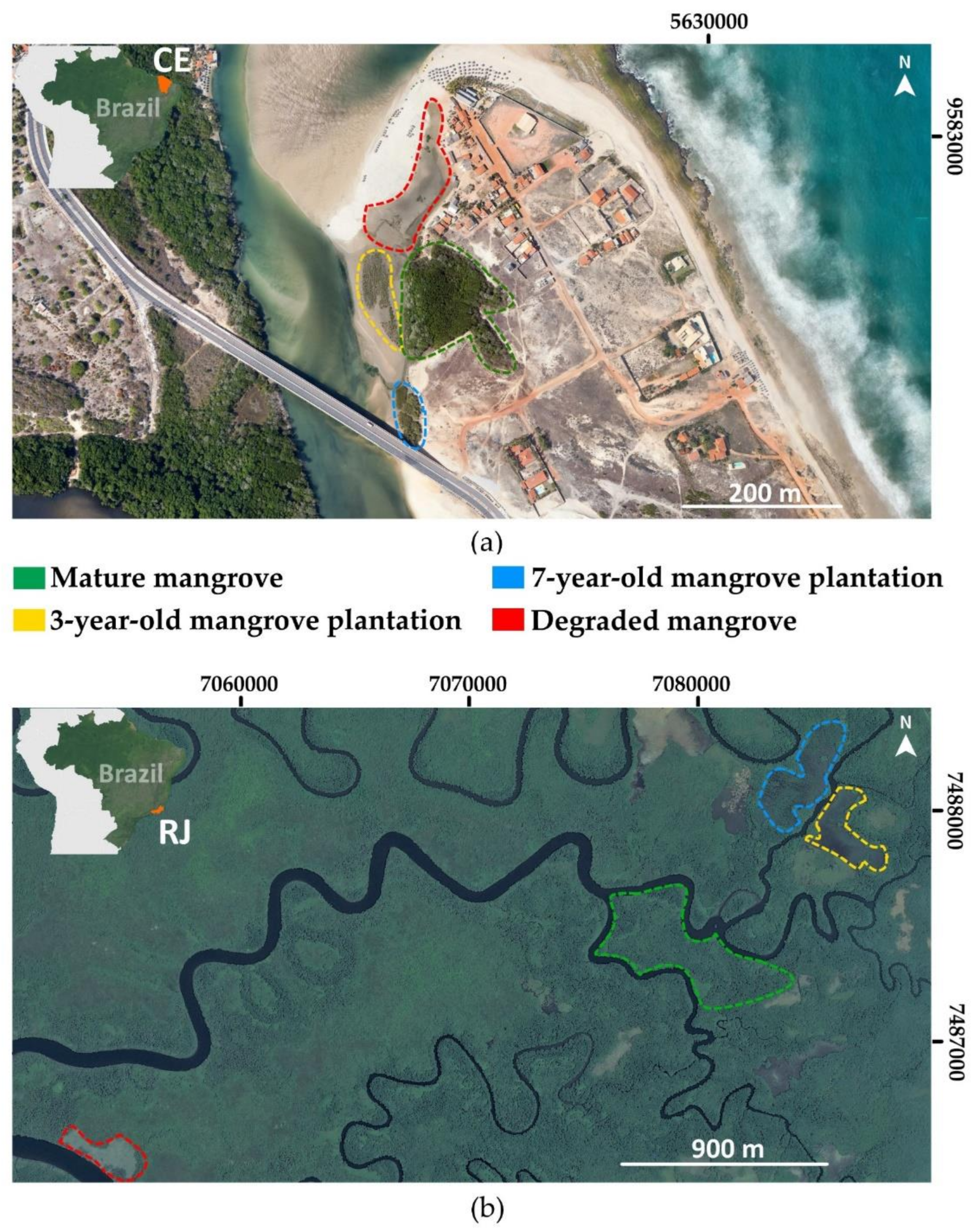
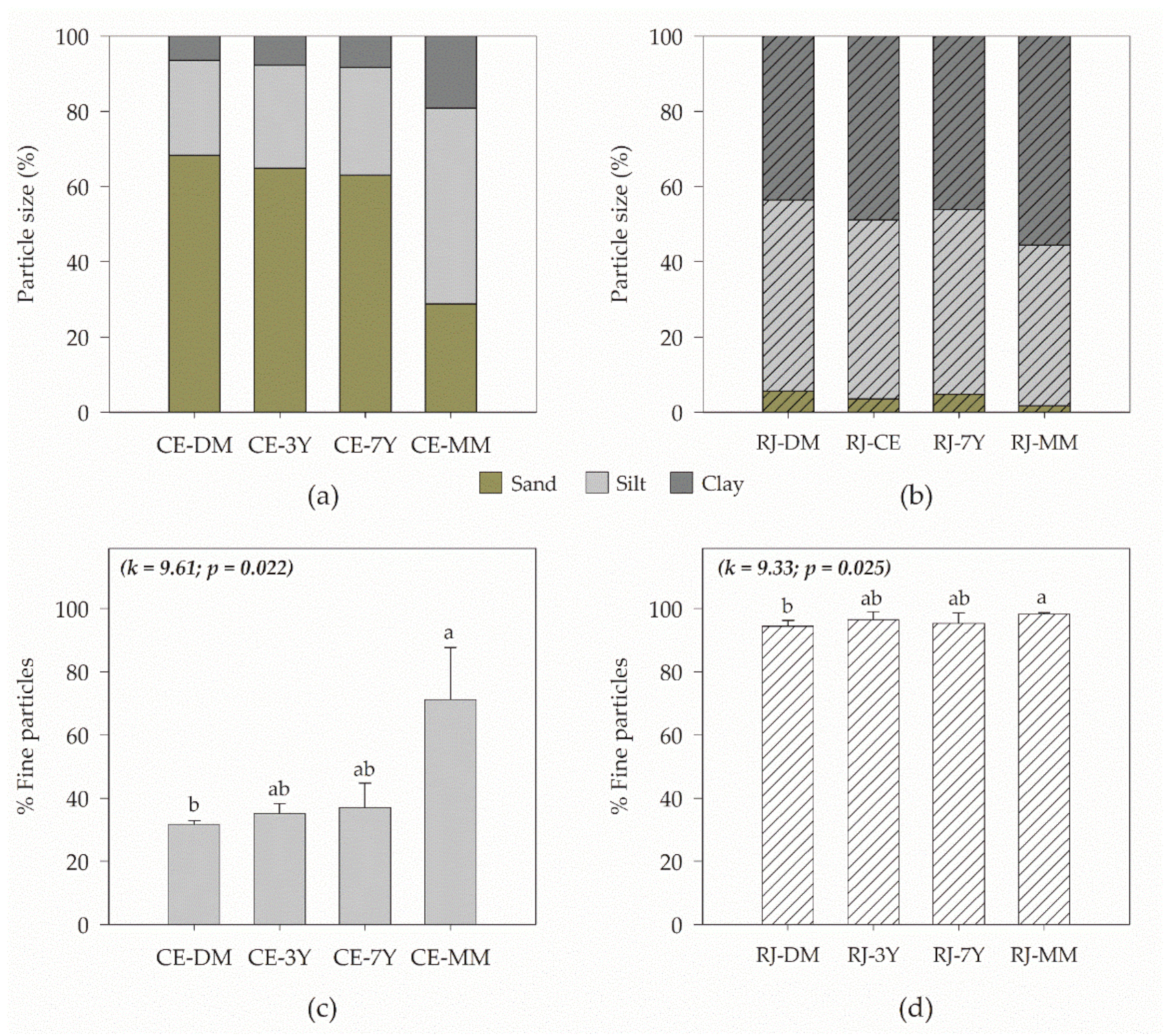
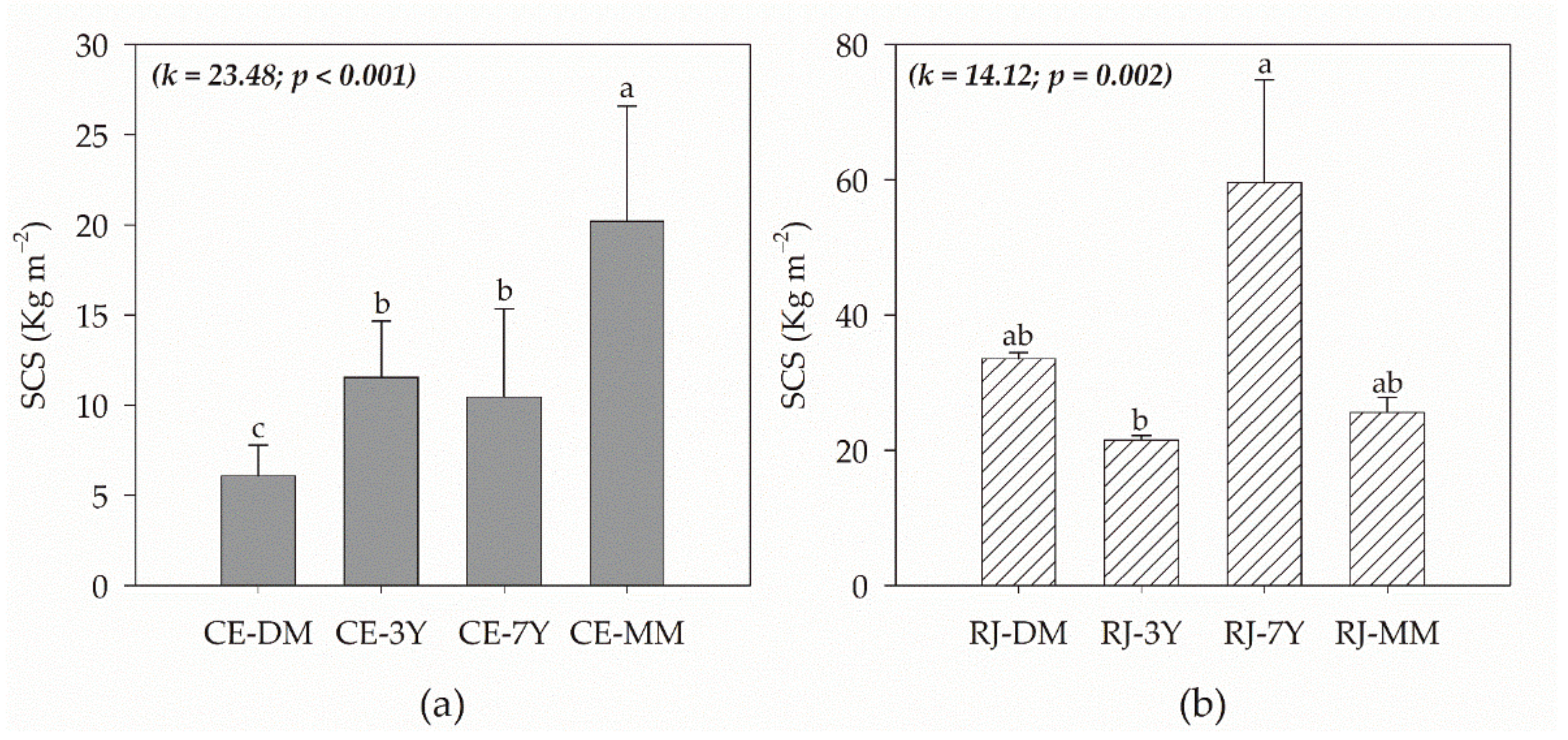
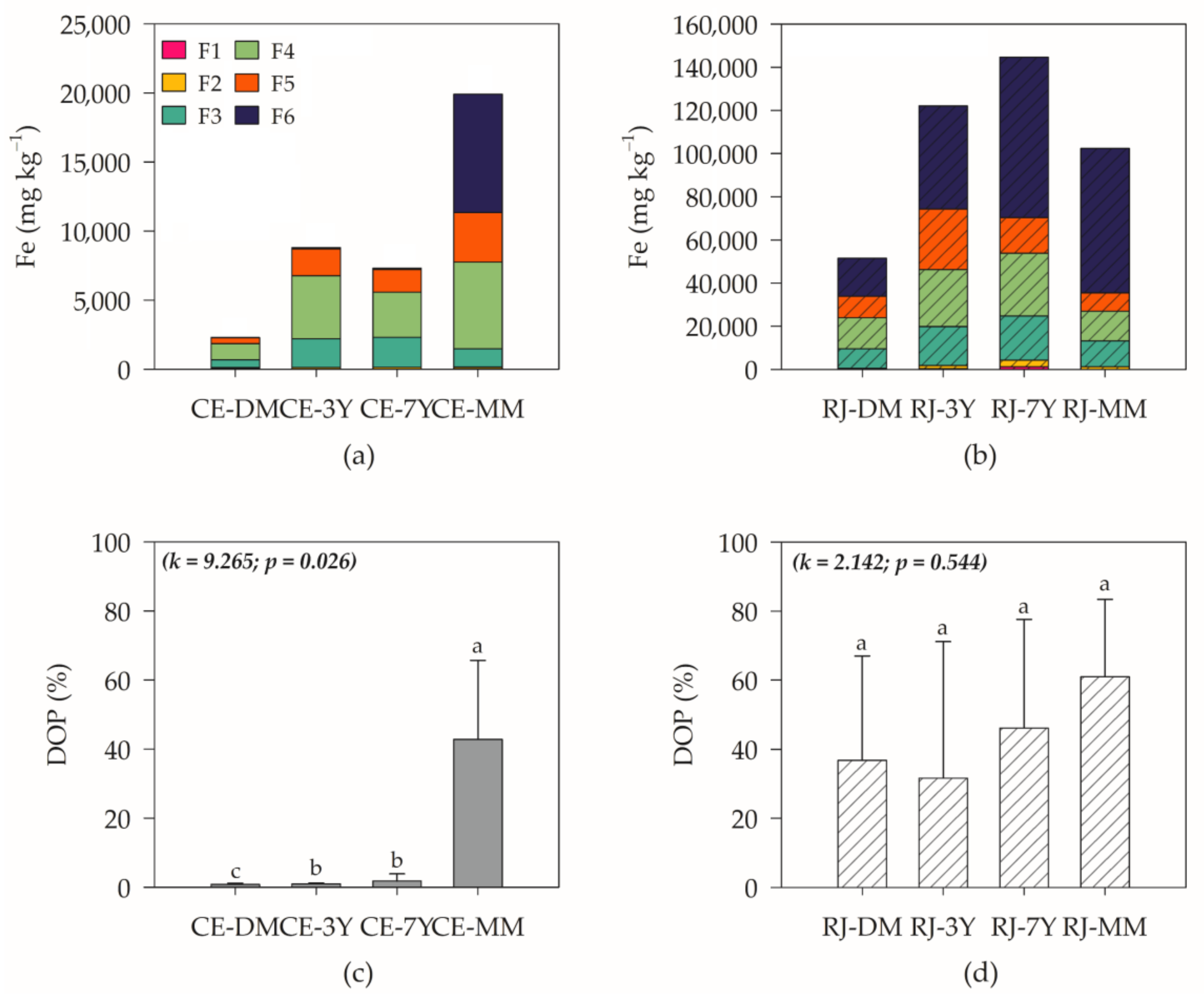

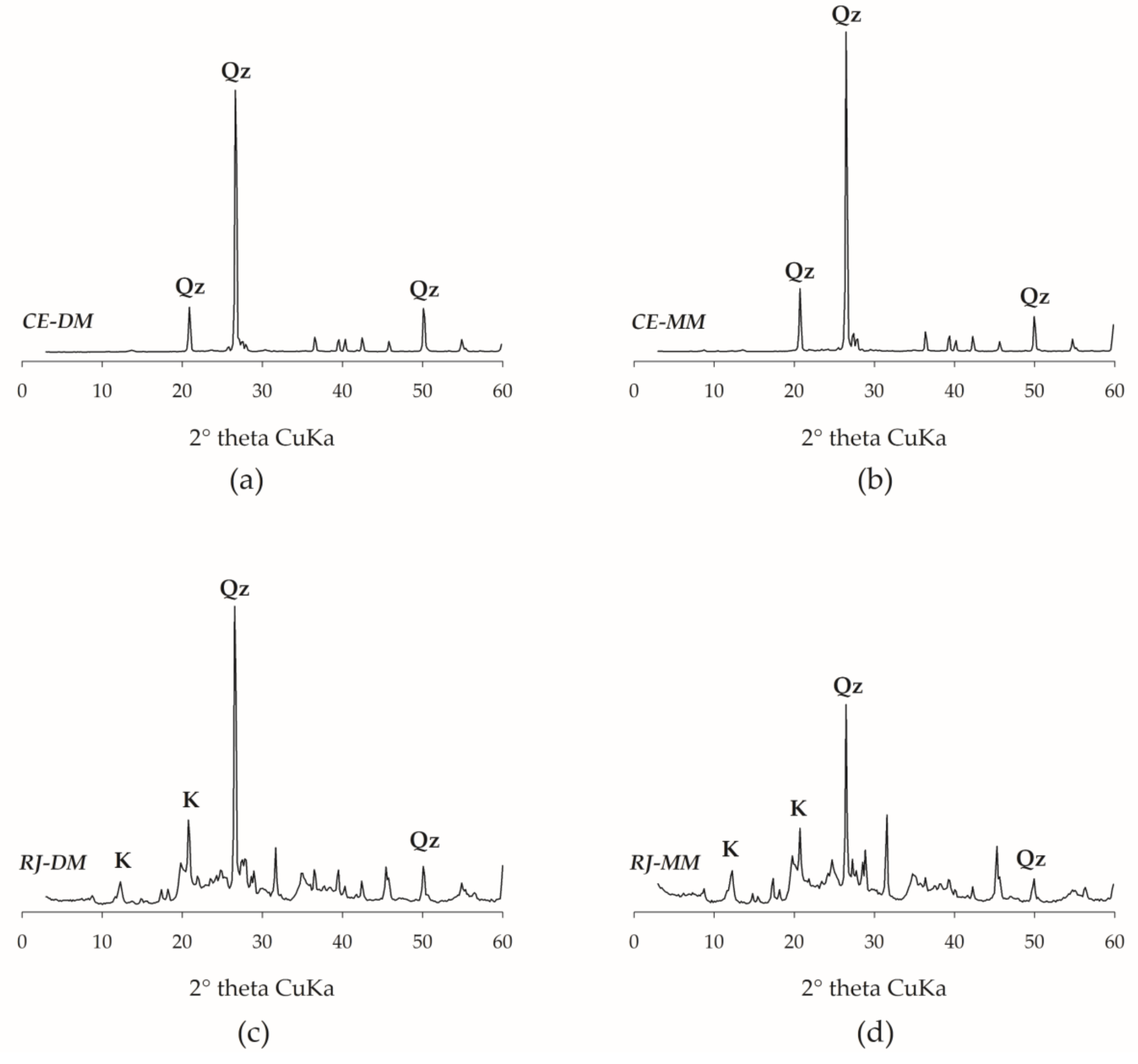
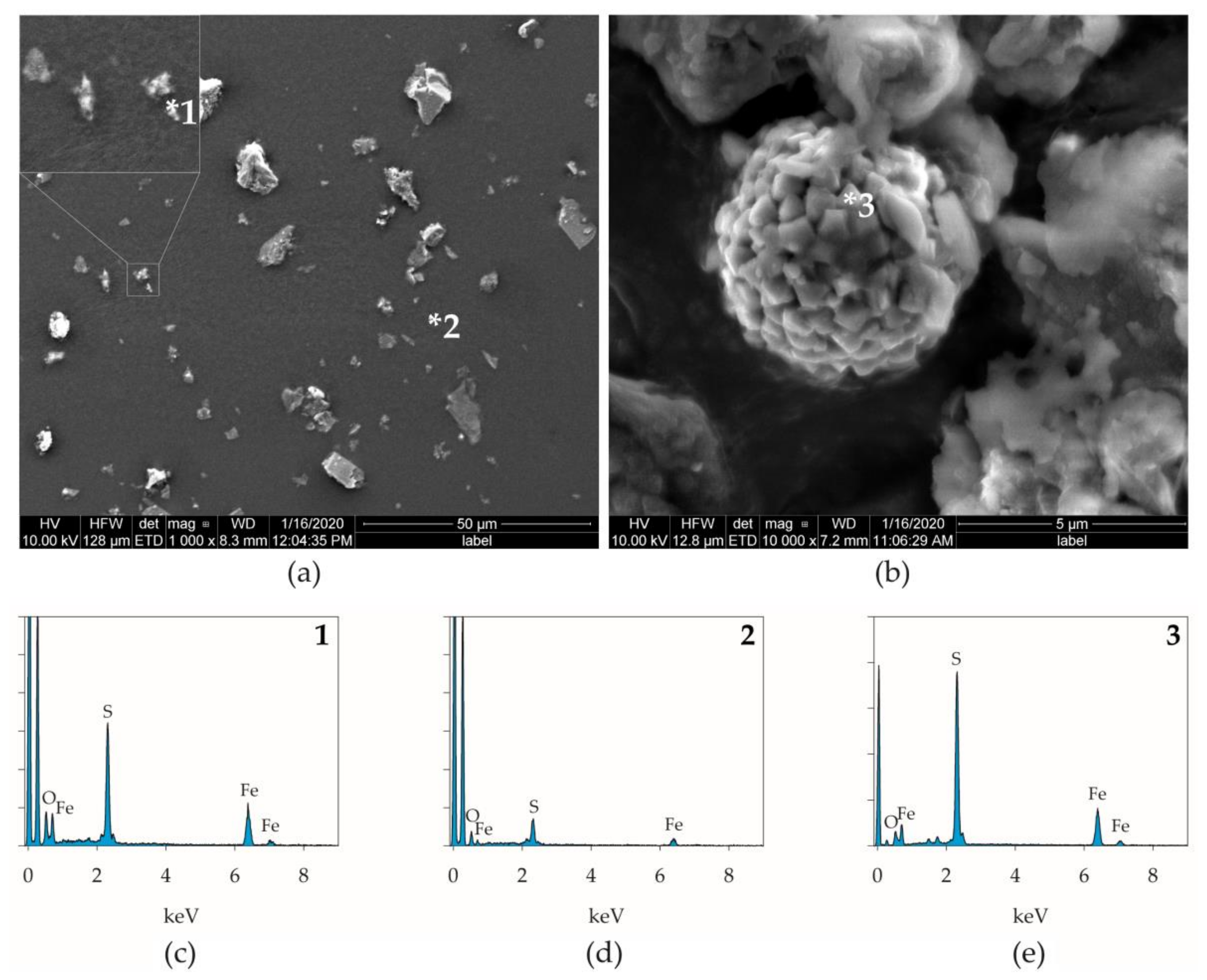

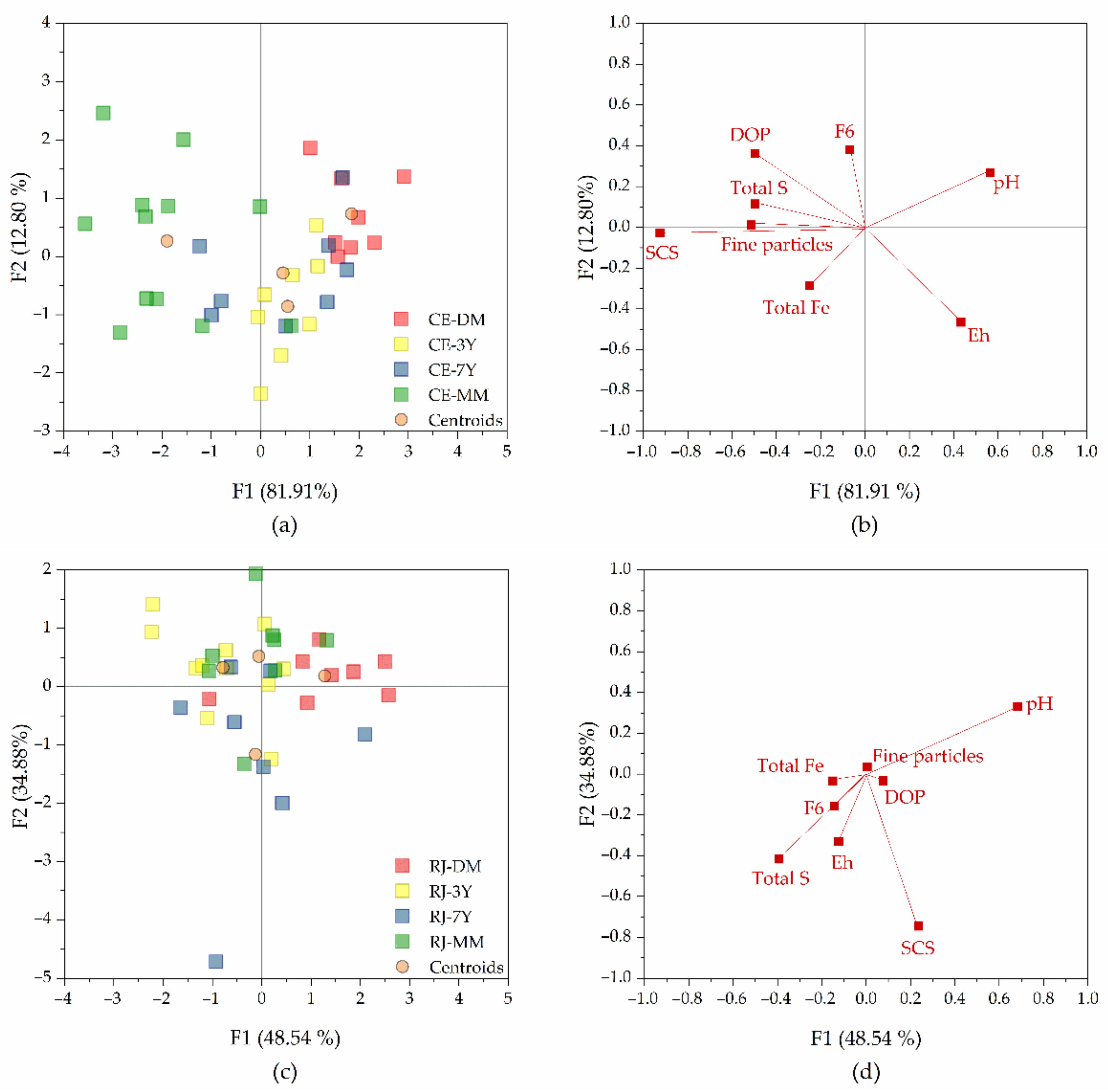
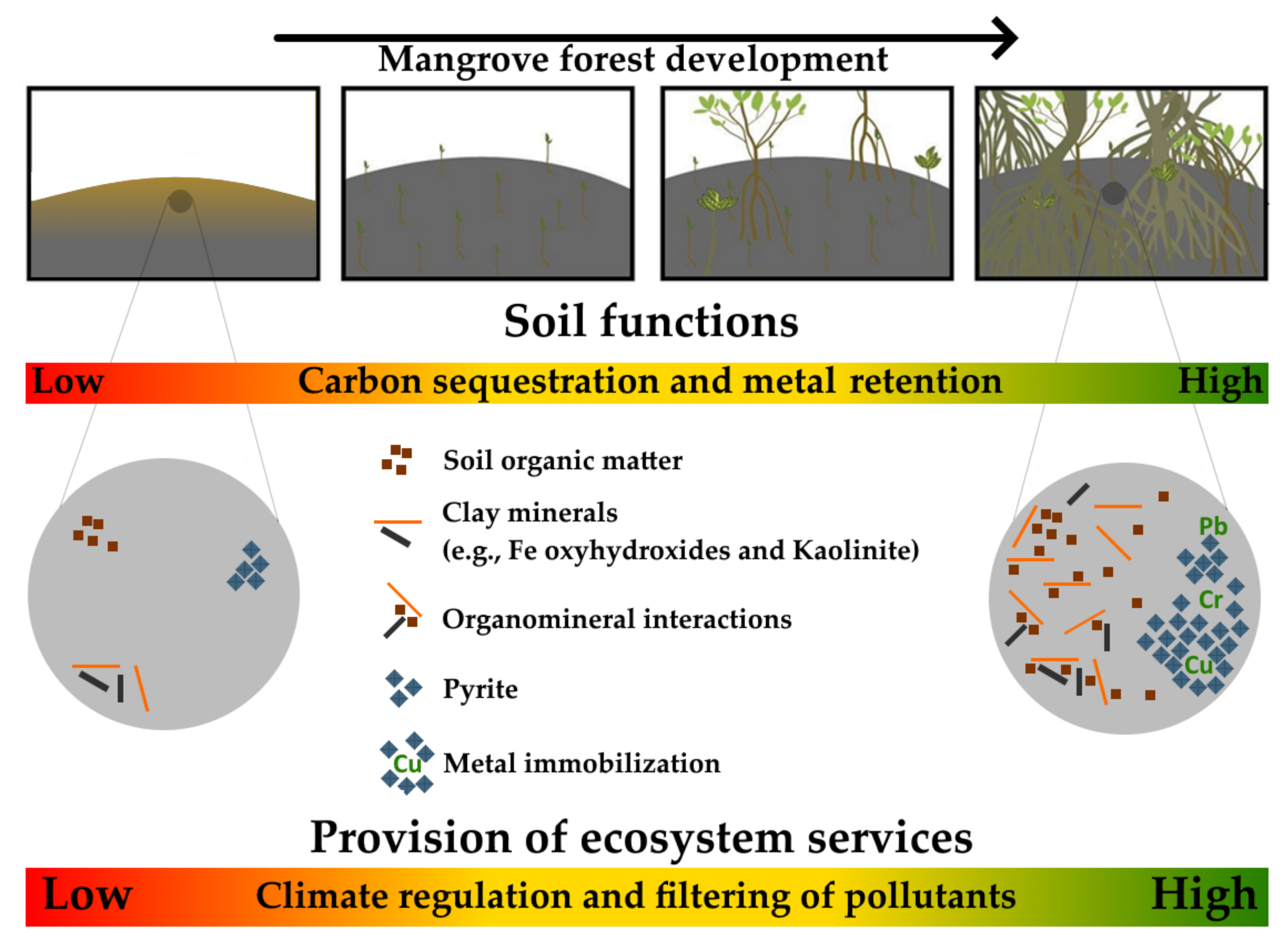
| Plot | Location (UTM) | Climate * | Geological Surroundings | Eh | pH | Tidal Regime | Forest Features |
|---|---|---|---|---|---|---|---|
| Ceará | |||||||
| DM | 562,638.15 m E 9,582,935.79 m S | BSh | Sedimentary deposists | +425 ± 28 mV | 7.0 ± 0.2 | Mesotidal (0.75 to 3.25 m) | No vegetation |
| 3Y | 562,577.33 m E 9,582,811.95 m S | BSh | Sedimentary deposits | +450 ± 16 mV | 7.0 ± 0.1 | Mesotidal (0.75 to 3.25 m) | RM |
| 7Y | 562,624.41 m E 9,582,661.79 m S | BSh | Sedimentary deposists | +437 ± 22 mV | 7.7 ± 0.3 | Mesotidal (0.75 to 3.25 m) | RM |
| MM | 562,669.31 m E 9,582,785.29 m S | BSh | Sedimentary deposists | +21 ± 163 mV | 6.3 ± 0.1 | Mesotidal (0.75 to 3.25 m) | AG, LR, and RM. |
| Rio de Janeiro | |||||||
| DM | 705,619.57 m E 7,486,388.30 m S | Af | Granitic–gneissic rocks | +250 ± 25 mV | 6.9 ± 0.2 | Microtidal (0.1 to 1.2 m) | AG, LR, and RM. |
| 3Y | 708,610.57 m E 7,487,890.50 m S | Af | Granitic–gneissic rocks | +340 ± 53 mV | 6.9 ± 0.1 | Microtidal (0.1 to 1.2 m) | AG, LR, and RM. |
| 7Y | 708,487.00 m E 7,488,109.00 m S | Af | Granitic–gneissic rocks | +408 ± 147 mV | 7.3 ± 0.3 | Microtidal (0.1 to 1.2 m) | AG, LR, and RM. |
| MM | 707,915.30 m E 7,487,394.68 m S | Af | Granitic–gneissic rocks | +424 ± 197 mV | 7.2 ± 0.2 | Microtidal (0.1 to 1.2 m) | AG, LR, and RM. |
Publisher’s Note: MDPI stays neutral with regard to jurisdictional claims in published maps and institutional affiliations. |
© 2022 by the authors. Licensee MDPI, Basel, Switzerland. This article is an open access article distributed under the terms and conditions of the Creative Commons Attribution (CC BY) license (https://creativecommons.org/licenses/by/4.0/).
Share and Cite
Jimenez, L.C.Z.; Queiroz, H.M.; Nóbrega, G.N.; Romero, D.J.; Deng, Y.; Otero, X.L.; Ferreira, T.O. Recovery of Soil Processes in Replanted Mangroves: Implications for Soil Functions. Forests 2022, 13, 422. https://doi.org/10.3390/f13030422
Jimenez LCZ, Queiroz HM, Nóbrega GN, Romero DJ, Deng Y, Otero XL, Ferreira TO. Recovery of Soil Processes in Replanted Mangroves: Implications for Soil Functions. Forests. 2022; 13(3):422. https://doi.org/10.3390/f13030422
Chicago/Turabian StyleJimenez, Laís Coutinho Zayas, Hermano Melo Queiroz, Gabriel Nuto Nóbrega, Danilo Jefferson Romero, Youjun Deng, Xosé Luis Otero, and Tiago Osório Ferreira. 2022. "Recovery of Soil Processes in Replanted Mangroves: Implications for Soil Functions" Forests 13, no. 3: 422. https://doi.org/10.3390/f13030422
APA StyleJimenez, L. C. Z., Queiroz, H. M., Nóbrega, G. N., Romero, D. J., Deng, Y., Otero, X. L., & Ferreira, T. O. (2022). Recovery of Soil Processes in Replanted Mangroves: Implications for Soil Functions. Forests, 13(3), 422. https://doi.org/10.3390/f13030422








